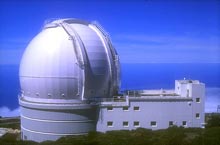
A research team jointly involving the IRD, the CEA and the CNRS has very recently found phytochromes in a strain of nitrogen-fixing bacterium, Bradyrhizobium (1), symbiont on certain tropical leguminous plants (the Aeschynomene). Techniques of molecular biology, biophysics and biochemistry revealed that the newly-discovered phytochrome has an essential role as regulator of the bacterium’s photosystem synthesis. An identical function was shown in the photosynthetic bacterium Rhodopseudomonas palustris

A model of a system for growing plants to plan biological experiments in space has just left the company of ROVSING, in Ballerup near Copenhagen, on its way to ESA’s European Space Research and Technology Centre (ESTEC) in the Netherlands.
The full name of this experiment reference model is European Modular Cultivation System Experiment Reference Model (EMCS ERM). This will be used at ESTEC to plan and carry out experiments for growing plants in space. Then in 2003 the EMCS Flight Model will

A team of UK astronomers announced this month the discovery of cannibalistic stars that explain one of the mysteries surrounding the Big Bang. The stars are almost as old as the Universe and they reveal what space was like in the very beginning.
The team from the Open University found that a group of 14-billion-year-old stars were all in a spin (literally) because of a nasty phase earlier in their lives. They were, in short, cannibalistic stars. The scientists` discovery not only explains

iver air bags offer relatively little benefit in road vehicle crashes compared with seat belts, finds a study in this week’s BMJ.
Researchers in the United States identified all passenger vehicles that crashed during 1990-2000 in which the driver or passenger, or both, died. A sample of 51,031 driver-passenger pairs was analysed to estimate the association of driver air bags with driver fatality.
Having an air bag was associated with an 8% reduction in the risk of death, whether the

Road vehicles may soon be fitted with pop-up bonnets, windscreen airbags and energy absorbing bumpers to improve pedestrian safety, according to researchers in this week’s BMJ.
Collisions between pedestrians and road vehicles are responsible for more than a third of all traffic related fatalities and injuries worldwide, yet research has so far concentrated almost exclusively on increasing the survival of vehicle occupants, argue researchers at the University of Virginia, USA.
Crash

Record low numbers of highly-prized squid have devastated the Falkland Islands fishery this year. Less than 10,000 tonnes have been caught so far, making this the worst year since the fishery began in 1987. As described in this week`s SCIENCE British Antarctic Survey (BAS) scientists believe unfavourable oceanographic conditions in squid spawning grounds caused the slump in the fishery which is normally worth £17 million ($US 25 million) in licence fees.
The flying squid Illex argentinu

– new calculation confirms standard model of particle physics. Contribution of hadronic vacuum polarization determined with unprecedented accuracy. The magnetic moment of the muon is an important precision parameter for…
Technique may prevent formation of unwanted waves that siphon off needed energy. Heating plasma to the ultra-high temperatures needed for fusion reactions requires more than turning the dial on a…

An international team of astronomers, led by researchers from the Astronomical Observatory of the University of Warsaw, have identified a new class of cosmic X-ray sources. The findings have been…

Antibody that Neutralizes Inhibitory Factors Involved in Nerve Regeneration Leads to Enhanced Motor Function after Acute Spinal Cord Injury. Researchers at 13 clinics in Germany, Switzerland, the Czech Republic and…

How the body’s natural killer cells could fight leukemia. Every year, some 13,000 people in Germany are diagnosed with leukemia. Despite intensive chemotherapy, around one in two of them die….

… eco-friendly reactor converts air and water into ammonia. Producing enough ammonia to feed the world comes with a large carbon footprint;. process described in new UB-led study could help…

How simulations help manufacturing of modern displays. Modern materials must be recyclable and sustainable. Consumer electronics is no exception, with organic light-emitting diodes (OLEDs) taking over modern televisions and portable…

“Neurons that fire together, wire together” describes the neural plasticity seen in human brains, but neurons grown in a dish don’t seem to follow these rules. Neurons that are cultured…

The quest for sustainable energy solutions has been a major focus of scientific research for decades. Solar energy, a clean and renewable source, has emerged as a promising alternative to…

With a processing speed a billion times faster than nature, chip-based laser neuron could help advance AI tasks such as pattern recognition and sequence prediction. Researchers have developed a laser-based…

New technology could remotely identify various types of plastics, offering a valuable tool for future monitoring and analysis of oceanic plastic pollution. Researchers have developed a new hyperspectral Raman imaging…

Artificial Intelligence (AI) has established a strong presence across industries, large and small. The “VoBaKI” research project has empowered small and medium-sized enterprises (SMEs) with an innovative tool to independently…